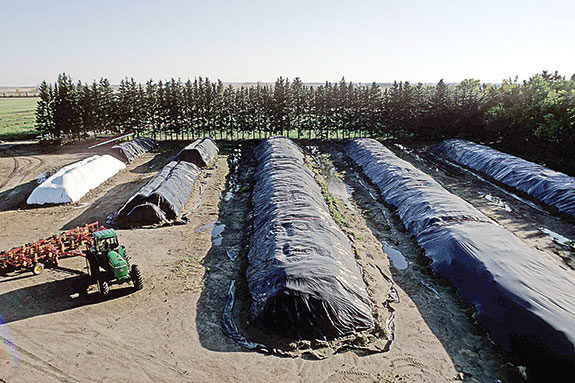If the baleage you uncover is sweet-smelling, has a uniform color and is relatively free of visible mold, congratulations; keep on doing what you are doing.
If you find you have little or no apparent fermentation and see pockets or extensive areas of visible spoilage and mold, the following may help you understand why and take steps to prevent a repeat occurrence in the future.
Choice of storage method
All methods for making bale silage are based on sealing bales in plastic to prevent exposure to air.
These include covering stacks of bales with sheets of plastic or enclosing them in tubes, enclosing single bales in tubes or bags, or tightly wrapping bales in overlapping sheets of stretch plastic film as a tube or individually.
Plastic and labor cost per unit of dry matter ensiled dramatically increases as one moves from multiple bale sheet covering to plastic tubes to individual wrapping.
However, this increased cost is often offset by a substantial decrease in risk and incidence of spoilage – for the reason described below.
Why does bale silage like to mold?
Silage spoils due to the growth of aerobic organisms (mostly yeast and fungi) that exist at harvest but remain dormant until the appropriate environment occurs during storage.
All silage spoilage is due to infiltration of air into the silo, or more specifically oxygen in the air. It takes relatively little, and mostly occurs during storage, though the air that is present in and around the bales when ensiled does not appear to be a factor.
Recent experience suggests that once a silo is sealed, the oxygen present may be consumed in as little as 15 minutes by cell respiration and initial fermentation.
If the plastic barrier does not completely exclude air entry during storage, the bale silage is particularly susceptible to spoilage for the following reasons:
1. Bale silage does not pack to the same extent as chopped silage and is thus more permeable to air diffusion within, and especially between, bales.
2. Bale silage fermentation is less extensive than with chopped silage, resulting in lower concentrations of silage acid and higher pH, and thus less resistance to mold growth.
3. Bale silage tends to be put up at a higher dry matter content than chopped silage, which further decreases the extent of fermentation, as well as increases gas permeability within the bale.
4. A larger proportion of bale silage is in close contact with the surface of the “silo” compared with more conventional structures.
5. Loose plastic and space between bales appear to create areas that infiltrated air can accumulate, travel and warm sufficiently to permit surface mold growth, even in colder climates.
Closely fitting plastic wrap is advantageous in that, by being in close contact with the bales, it limits the ability of both the plastic and any air that enters the bale to rise above the temperature of the bale.
Methods to limit mold growth in bale silage
Obviously the secret to limiting molding and spoilage of bale silage is to first ensile forages that are capable of optimal fermentation, and then store it in a plastic enclosure that is impervious to oxygen infiltration. Easy, right?
If it wasn’t for the challenge of the cost of the plastic, equipment and labor to do it; technological limitations; and then the holes created by protruding stems, rocks, wind, tears, birds, animals and vermin – there would be nothing to it.
Depending on the storage method you use, keep the following points in mind for greater success:
• Use the correct type and amount of plastic.
Most recommendations call for a minimum of six mils of plastic that has been specifically designed and tested for covering silage.
Construction and other types of plastic can have variable thickness and porosity to oxygen or lack UV inhibitors required to prevent breakdown from exposure to sunlight, all of which increase the potential for spoilage and molding.
Recent recommendations for covering stacked bales with sheet plastic call for the use of two six-mil sheets of plastic: an inner one to encase the forage and an outer one to seal the silo.
This lessens the risk of punctures and tears from plastic movement against protruding stems.
• Tighten and seal the plastic.
Within a structure, bales should be packed as tightly together as is possible, especially the butt ends, and then the plastic tightened around them to restrict air flow around and among the bales as well as possible.
Researchers at the Agriculture and Agri-Food Canada Research Station in Melfort, Saskatchewan, found that using sand to simultaneously weigh down and tuck the edges of plastic sheets under the bottom edges of stacked bales served well to both tighten the plastic and seal the structure.
Looping a rope around the bottom of a stack can help with initial tightening and holding of the plastic until the sand is added. Sand can also be used to tighten plastic covering multiple bales stored in large tubes.
The Melfort researchers also confirmed that using a wet-dry vacuum to tighten and remove excess air from loose plastic did not enhance fermentation nor decrease subsequent entry of air into the stack.
Gas production from forage cell respiration and fermentation simply allowed the plastic to loosen again.
• Vent excess gas production.
Optimal lactic acid-based silage fermentation should produce very little gas. Yet it is not uncommon for stacked bale silage to undergo prolonged cell respiration or non-lactic acid fermentation, which can form large amounts of carbon dioxide and cause extreme inflation of plastic covers within the first two to three days of ensiling.
Such inflation stretches the plastic, reduces its thickness, creates pin holes, loosens the plastic and increases its overall porosity to oxygen, and should therefore be relieved as soon as possible by venting.
In urgent cases, it may be best to simply cut six-inch to eight-inch slits in the plastic at a few locations along the stack and then patch the cuts with a suitable tape once the gas has dissipated.
If inflation is a recurring problem, commercial, reusable vents such as the Ag-Bag Vent Valve are available to be installed at filling and then opened when needed.
At the Melfort Research Station, workers secured a short length of 1½-inch-diameter PVC pipe into the plastic with tape and used a wet-dry vacuum to remove excess gas, being careful to stop before creating a vacuum and risk drawing in fresh air.
The open end of the pipe can be sealed with tape or a PVC end cap. Alternatively, a vertical one-way vent can be created by adding a water or sewer check valve to the top, or a short length of larger-diameter pipe containing a rubber ball large enough to block the 1½-inch pipe.
When gas production ceases, all vents should be permanently sealed.
• Monitor and fix all holes, frequently.
Other than a seal failure, most air entry and spoilage occurs due to the development of tears and holes during storage. Robert Westra, a silage specialist in western Canada, states that a two-millimeter to three-millimeter (1/8-inch) hole in a plastic cover can cause an area of spoilage up to a meter in diameter beneath it.
It is therefore essential that all plastic covers are regularly inspected as often as required, even weekly, to ensure a seal is being maintained and to find and repair tears and holes as they occur.
This is especially true for stacked bales or when the plastic may be loose or there are voids under the plastic. In these cases, such spoilage can extend over many meters and potentially the length of a stack, especially if there are multiple holes.
• Limit feedout time.
As soon as the “silo” is opened, the silage is exposed to the air and spoilage can begin. The extent to which actual spoilage occurs will mostly depend on the temperature, silage moisture, acid content and the ability of air to diffuse through the silage.
With stacked bales, however, the air can easily travel the length of the stack and start creating spoilage deep within.
Consequently, prolonged feedout could cause extensive spoilage to bales deeper in the stack. In such cases, it may be best to store bales in units that can be fed out within one to two weeks, or otherwise feed them out during cold weather.
It is clear that good-quality bale silage can be made and stored using a number of methods. However, it is also clear that success in limiting spoilage when using the lower-cost, multiple-bale methods requires much more attention to detail and effort in ensuring optimal fermentation and maintenance of a sealed structure; otherwise spoilage losses can be substantial. FG
Duane McCartney is a retired forage and beef researcher with Agriculture and Agri-Food Canada.
PHOTO
If the plastic barrier does not completely exclude air entry during storage, bale silage is particularly susceptible to spoilage. Photo courtesy of Alan Vaage.
Alan S. Vaage
Ruminant Nutritionist
Jaylor











